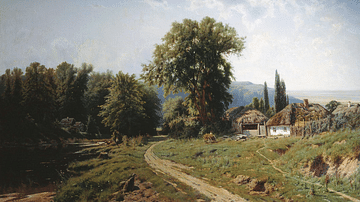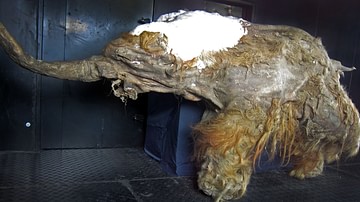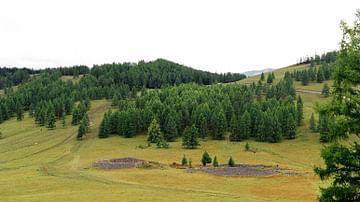Search
Did you mean: Minerva?
Search Results

Article
Prehistoric Hunter-Gatherer Societies
Hunter-gatherer societies are – true to their astoundingly descriptive name – cultures in which human beings obtain their food by hunting, fishing, scavenging, and gathering wild plants and other edibles. Although there are still groups of...

Article
The Stolypin Reforms - Tsar Nicholas II's Attempt to Stave off Revolution
Pyotr Stolypin (1862-1911) was a Russian politician who served as prime minister to Tsar Nicholas II (reign 1894-1917). Stolypin ruthlessly quashed anti-Tsarist rebellions after the Russian Revolution of 1905 but was also responsible for...

Image
Young Woolly Mammoth Carcass
This carcass of a young woolly mammoth, nicknamed 'Yuka', is on display in Moscow after being found in an astonishingly good condition in Siberia. It died around 39,000 years ago and was between 6 and 11 years old.

Image
Scythian Belt Buckle
Scythian belt buckle, Southern Siberia, 3rd century BCE.
Hermitage Museum, St. Petersburg.

Image
Pazyryk Kurgans
The Pazyryk burials are a series of Iron Age Scythian tombs in the Ukok Plateau, Siberia. The tombs are dated to between the 4th and 3rd Century BCE.

Image
Denisova Cave
Denisova Cave in the Altai Mountains in Siberia, Russia. It is well known for human occupation stretching back as far as 280,000 years ago and shows signs of occupation by Neanderthals, Homo sapiens and Denisovans. All currently known Denisovan...

Video
Scythians: the alternative lifestyle of antiquity
Curator St John Simpson explains how the nomadic Scythians may not have lived in cities, but they still had the skill and desire to live the good life. The BP exhibition Scythians: warriors of ancient Siberia 14 September 2017 – 14 January...

Video
The Rise & Fall of the Mongol Empire - Anne F. Broadbridge
Trace the rise and fall of the Mongol Empire which, under the leadership of Genghis Khan, became the largest contiguous land empire in history. — It was the largest contiguous land empire in history— stretching from Korea to Ukraine...

Video
Scythians: Scientific Analysis of the Oxus Treasure
British Museum Scientist Aude Mongiatti shares some of her research on the Oxus treasure, a selection of beautiful gold and silver objects from the 5th and 4th centuries BC. Some of the objects from the Oxus treasure are on display in...

Definition
German-Soviet War - WWII's Bloodiest Front
The German-Soviet War, known in the USSR and today's Russia as the Great Patriotic War or, in Western Europe, as the Eastern Front of the Second World War (1939-45), began in June 1941 with Operation Barbarossa and ended in Germany's total...